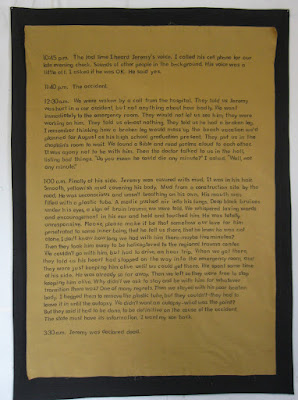I'm especially interested in using gray, and I don't have enough range of hue. I did some dyeing last week to explore other grays. In the photo below, the top row is a color recipe that came out gray when I dyed it two years ago; I repeated it to get a gradation of values. But this time it came out tan rather than gray, either because of the age of the dyes (a few years old), or because I made a mistake in measuring. Oh well, a nice tan to add to my drawer. The second row is a value gradation done with a new gray dye powder that is a pure color, which is unusual. Generally, both brown and black (and from them, tan and gray) are made from a mixture of three primaries: red, yellow, and blue. But this new product is just one color by itself, which means it will never split into the component colors as some of the mixtures can tend to do. It is also a nice neutral gray, which is not easy to achieve with mixtures. The bottom row is an array of six premixed blacks (from Prochemical Dye), diluted into the gray range, compared to a 7th (on the right), which is a recipe from Carol Soderlund. I'll do a value gradation of the most promising of them. For the dyers amongst you, I've listed the numbers of the ProChem blacks in the caption. Added to the grays I figured out from the dye run two years ago, this should give me enough of a range for the project.
 |
| Bottom row, from left, Prochem #628, 629, 604, 610, 610 plus 1/6 the amount of Strong Orange, 602A, Carol's black. |
And here are the results of testing out a variety of fabrics for hand-dyed napkins. These are all as they emerged from the dryer, as I want to use a fabric that does not necessarily need ironing.
From the left:
- Kaufman Patina, 100% cotton, done as a control for color uptake, as I know it dyes very well. It also came out of the dryer with few wrinkles. If I end up using cotton, I will likely go with this, rather than the Roclon Nature's Way muslin I used in earlier trials.
- A linen/rayon "hopsack" blend from JoAnn Fabrics. Good color uptake, and not badly wrinkled, but probably too heavy for a napkin, and the edges frayed badly.
- A linen/rayon blend from Dharma Trading Company. Less color uptake, pretty wrinkled, and fabric is not as soft as I would like for a napkin.
- A linen/cotton blend from Dharma. Poor color uptake, but everything else is good--not wrinkly, feels soft, heavier than cotton but still very nice for a napkin. It will be difficult to get dark colors with this one.
- A linen/rayon blend from JoAnn Fabrics that has an embroidered pattern sewn into the cloth. Good color uptake, but wrinkled the most of any of them.
So, I'll likely use Kaufman Patina or the linen/cotton blend.













